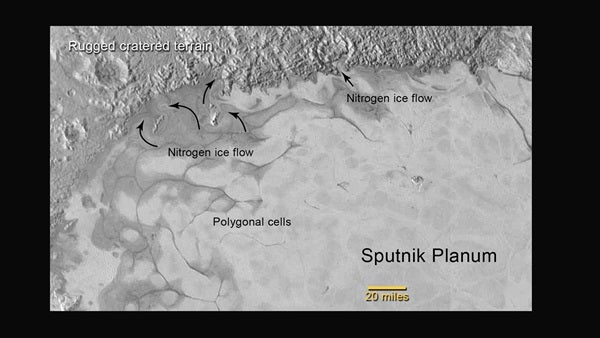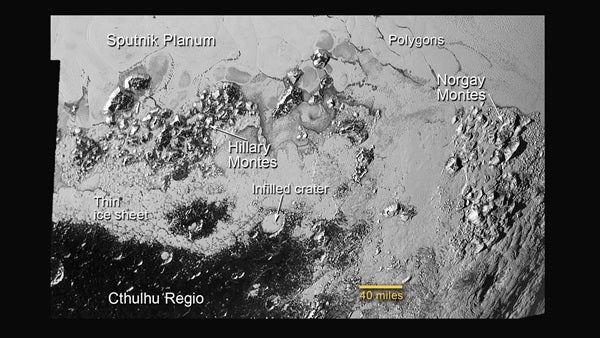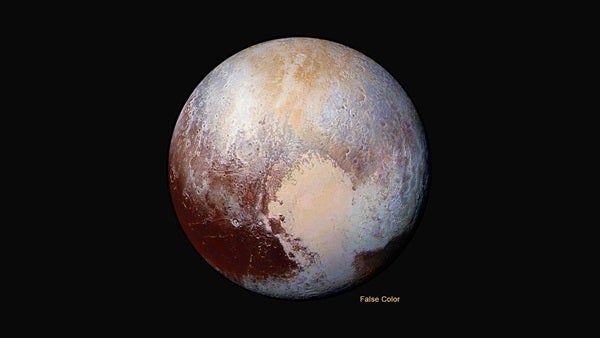Flowing ice and a surprising extended haze are among the newest discoveries from NASA’s New Horizons mission, which reveal distant Pluto to be an icy world of wonders.
“We knew that a mission to Pluto would bring some surprises, and now — 10 days after closest approach — we can say that our expectation has been more than surpassed,” said John Grunsfeld, NASA’s associate administrator for the Science Mission Directorate. “With flowing ices, exotic surface chemistry, mountain ranges, and vast haze, Pluto is showing a diversity of planetary geology that is truly thrilling.”
Related gallery: Pluto up close
Just seven hours after closest approach, New Horizons aimed its Long Range Reconnaissance Imager (LORRI) back at Pluto, capturing sunlight streaming through the atmosphere and revealing hazes as high as 80 miles (130 kilometers) above Pluto’s surface. A preliminary analysis of the image shows two distinct layers of haze — one about 50 miles (80km) above the surface and the other at an altitude of about 30 miles (50km).
“My jaw was on the ground when I saw this first image of an alien atmosphere in the Kuiper Belt,” said Alan Stern, principal investigator for New Horizons at the Southwest Research Institute (SwRI) in Boulder, Colorado. “It reminds us that exploration brings us more than just incredible discoveries — it brings incredible beauty.”
Studying Pluto’s atmosphere provides clues as to what’s happening below.
The hazes in Pluto’s atmosphere, observed by NASA’s New Horizons spacecraft on July 14, provide a crucial link between the sunlight-driven chemistry in the upper atmosphere and the reddish-brown hydrocarbons called tholins that rain down and darken the surface. The animation shows several steps: 1) Ultraviolet sunlight breaks apart methane in Pluto’s upper atmosphere. 2) This leads to the buildup of complex hydrocarbons, such as ethylene and acetylene. 3) Clumps of these hydrocarbons condense as ice particles to form the hazes. 4) The hazes are chemically converted to tholins, which fall to the surface and darken Pluto.
Models suggest the hazes form when ultraviolet sunlight breaks up methane gas particles — a simple hydrocarbon in Pluto’s atmosphere. The breakdown of methane triggers the buildup of more complex hydrocarbon gases, such as ethylene and acetylene, which also were discovered in Pluto’s atmosphere by New Horizons. As these hydrocarbons fall to the lower, colder parts of the atmosphere, they condense into ice particles that create the hazes. Ultraviolent sunlight chemically converts hazes into tholins, the dark hydrocarbons that color Pluto’s surface.
Scientists previously had calculated temperatures would be too warm for hazes to form at altitudes higher than 20 miles (30km) above Pluto’s surface.
“We’re going to need some new ideas to figure out what’s going on,” said Summers.
The new images show fascinating details within the Texas-sized plain, informally named Sputnik Planum, which lies within the western half of Pluto’s heart-shaped feature, known as Tombaugh Regio. There, a sheet of ice clearly appears to have flowed — and may still be flowing — in a manner similar to glaciers on Earth.
“We’ve only seen surfaces like this on active worlds like Earth and Mars,” said mission co-investigator John Spencer of SwRI. “I’m really smiling.”
“At Pluto’s temperatures of –390° Fahrenheit, these ices can flow like a glacier,” said Bill McKinnon, deputy leader of the New Horizons Geology, Geophysics and Imaging team at Washington University in St. Louis. “In the southernmost region of the heart, adjacent to the dark equatorial region, it appears that ancient, heavily cratered terrain [informally named Cthulhu Regio] has been invaded by much newer icy deposits.”
Simulated flyover of Pluto’s Sputnik Planum and Hillary Montes, created from New Horizons close approach images.
“For many years, we referred to Pluto as the Everest of planetary exploration,” said New Horizons Principal Investigator Alan Stern of the Southwest Research Institute, Boulder, Colorado. “It’s fitting that the two climbers who first summited Earth’s highest mountain, Edmund Hillary and Tenzing Norgay, now have their names on this new Everest.”
This pattern is dramatically interrupted by the bright “beating heart” of Pluto.
The “heart of the heart,” Sputnik Planum, is suggestive of a reservoir of ices. The two bluish-white “lobes” that extend to the southwest and northeast of the “heart” may represent exotic ices being transported away from Sputnik Planum.
The New Horizons mission will continue to send data stored in its onboard recorders back to Earth through late 2016. The spacecraft currently is 7.6 million miles (12.2 million km) beyond Pluto, healthy and flying deeper into the Kuiper Belt.













